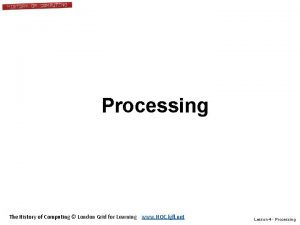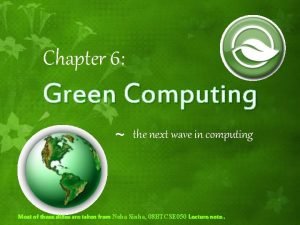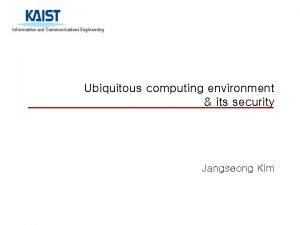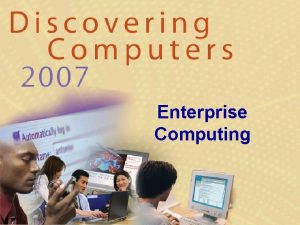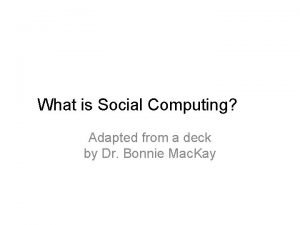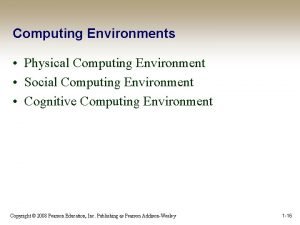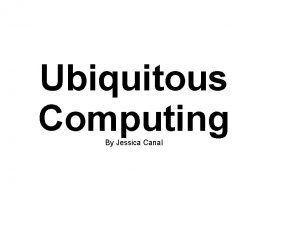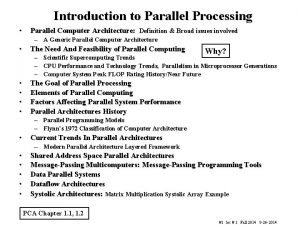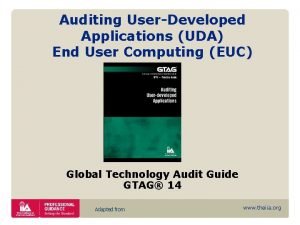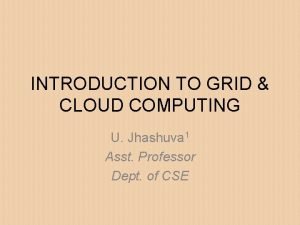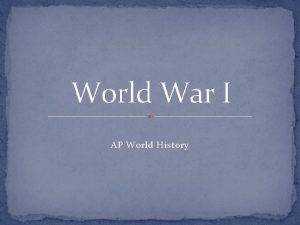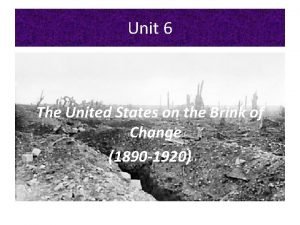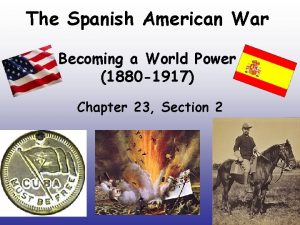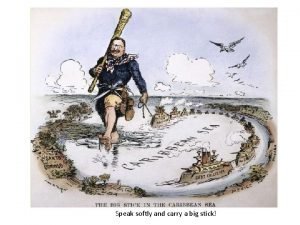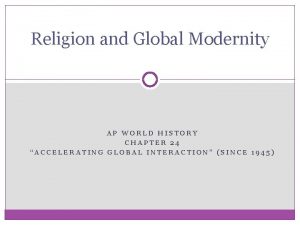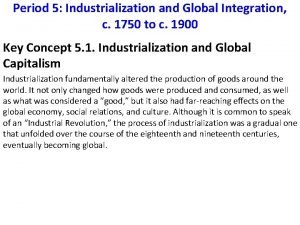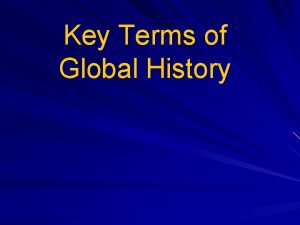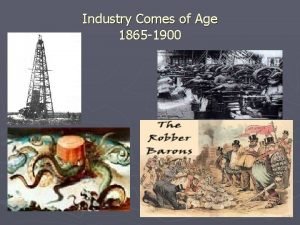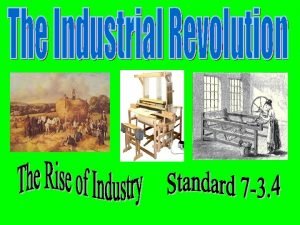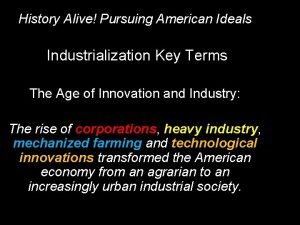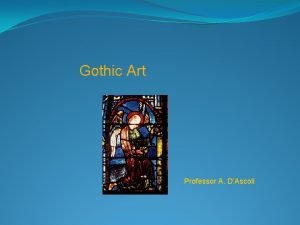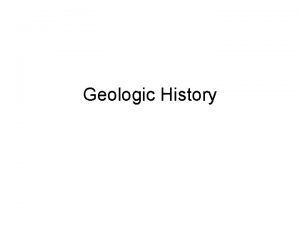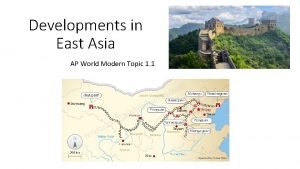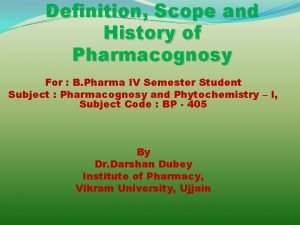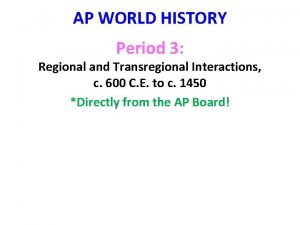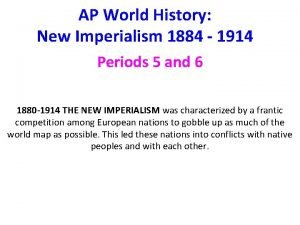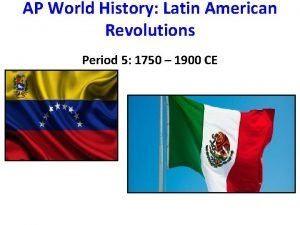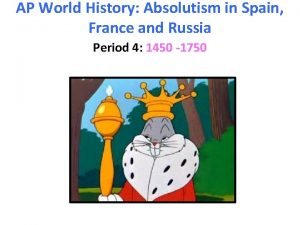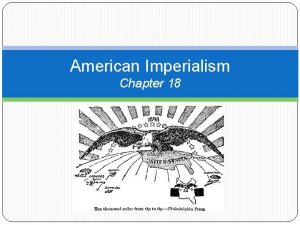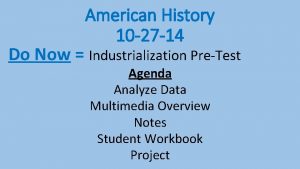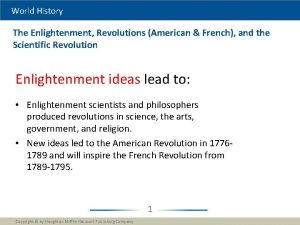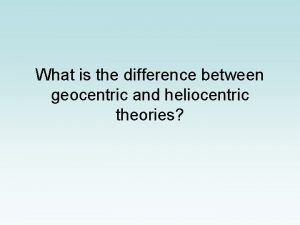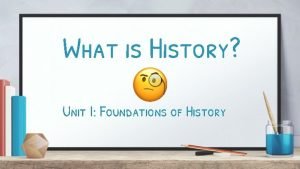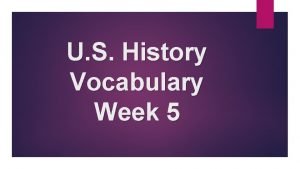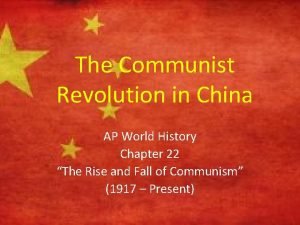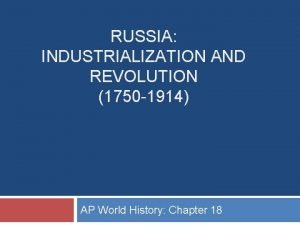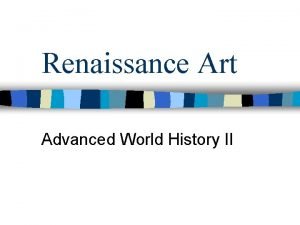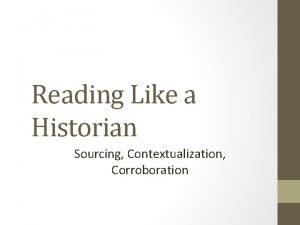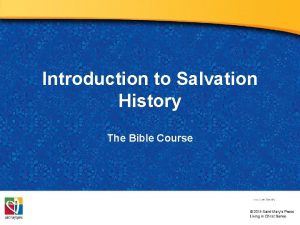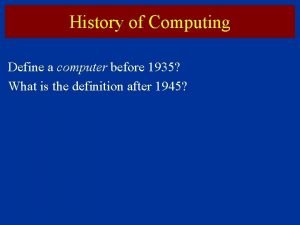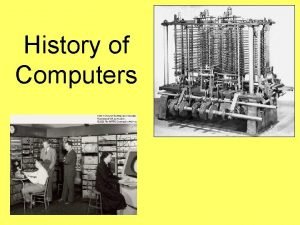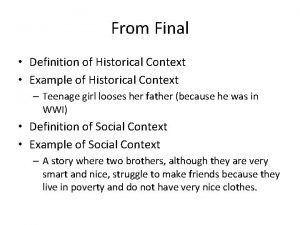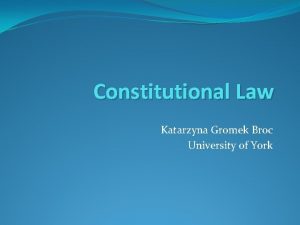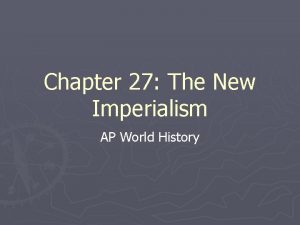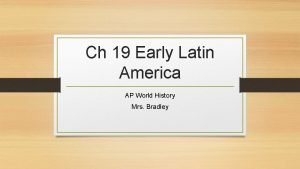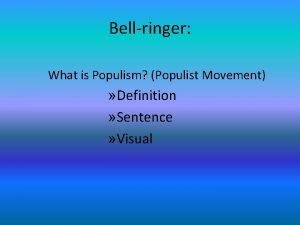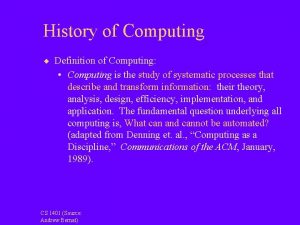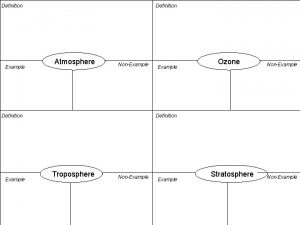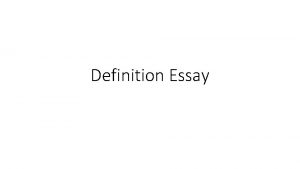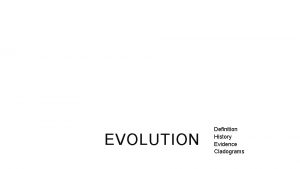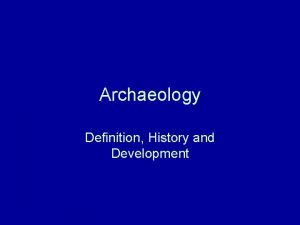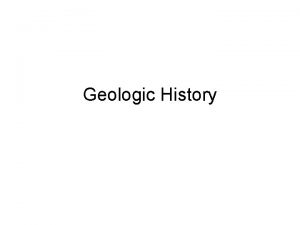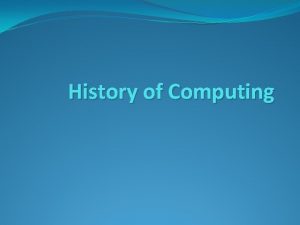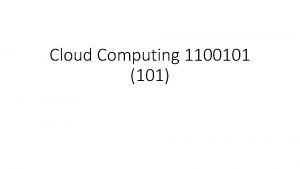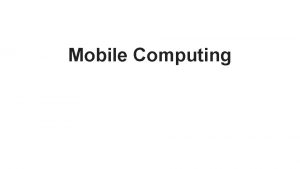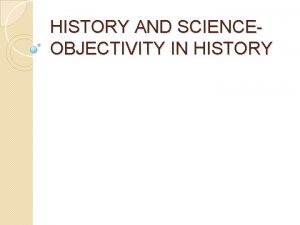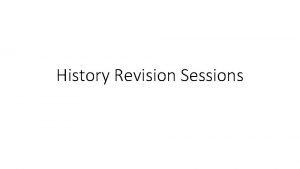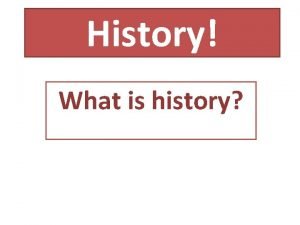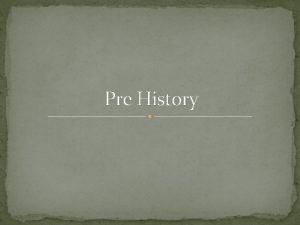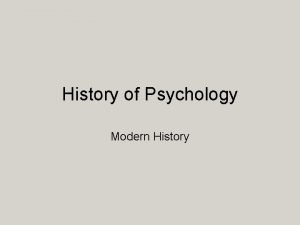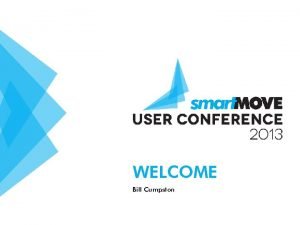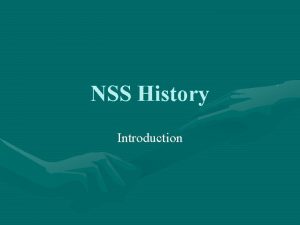History of Computing Definition of Computing Computing is



























































- Slides: 59

History of Computing ¨ Definition of Computing: • Computing is the study of systematic processes that describe and transform information: their theory, analysis, design, efficiency, implementation, and application. The fundamental question underlying all computing is, What can and cannot be automated? (adapted from Denning et. al. , “Computing as a Discipline, ” Communications of the ACM, January, 1989). CS 1401 (Source: Andrew Bernat)

History of Computing ¨ What is Process? • How we do things • How we specify what we do • How we specify what kinds of things we’re processing CS 1401 (Source: Mark Guzdial)

History of Computing ¨ What is an Algorithm? • Precise description of a process • Specifies exactly what is to be done in what order • Uses terms that can be completely defined and understood • Similar to a recipe • Word algorithm is derived from name of Persian textbook author al-Khowârizmî (approx. A. D. 825) • Word originally referred to process of using arithmetic computations using Arabic numerals CS 1401 (Source: Mark Guzdial, Andrew Bernat)

History of Computing ¨ A goal of computing If we: • Develop a computing machine • Specify a precise algorithm, represent the data used, and devise a way to translate all of this into a language (encoding) that our computing machine can “understand” Then, • Our computing machine can accurately, consistently, and more quickly carry out our computation for us CS 1401

History of Computing ¨ Prehistoric People Groups • Used fingers for counting, and length of hands and arms for measurements • Kept track of larger numbers, such as number of animals in herds, using small pebbles CS 1401

History of Computing ¨ People of Egypt, China and ancient Babylonia • By 3000 B. C. , had developed written symbols to represent numbers • Computational methods developed to save labor and solve practical eng. , ag. , bus. , and gov. problems (applied math) • Applications included measuring time, drawing straight lines, counting money, and computing taxes • Developed tables for multiplication, square and cube roots, exponents, formulas for quadratic equations • Babylonians and Egyptians not systematic reasoners; trial-and-error methods not always precise CS 1401 (Source: Andrew Bernat)

History of Computing ¨ Practical examples of geometry in ancient Egypt • Land surveying and navigation • Egypt was the “bread basket” of the world • Annual Nile River flooding fertilized plains but made it difficult to mark property • Geometry used to survey fields and reestablish property boundaries • Navigation required for food distribution • Building of pyramids required extensive measurements CS 1401

History of Computing ¨ Greece • Between 600 and 300 B. C. , inherited mathematical knowledge from Egypt and Babylon • Were the first to separate study of mathematics from application to practical problems • Developed foundation of formal logic: stated formal axioms, precise definitions, and patterns of valid reasoning • Pythagoras, Euclid, Archimedes, Ptolemy, and others developed extensive knowledge of geometry, trigonometry, algebra, astronomy and physics CS 1401

History of Computing ¨ Aristotle’s modus ponen example: If a student is a CS major, then the student takes CS 1401. You are a CS major. Therefore, you take CS 1401. Notice that the reasoning is valid, but this does not assure that the statements in the argument are true CS 1401

History of Computing ¨ Rome • Applied mathematics to practical tasks in business, civil engineering, and military work • Had little interest in study of pure mathematics CS 1401

History of Computing ¨ Middle Ages • No new mathematical advances in Europe for hundreds of years after fall of Rome in 476 A. D. • Arabs preserved mathematical knowledge developed by Greeks and Romans and expanded algebraic concepts • Concept of zero and decimal number system developed in India and used by Arabs • After 1100, growing commerce in Europe required an easier numbering system for merchants than Roman numerals • Europeans started using decimal number system and studying Arabic mathematical texts • During late Middle Ages, European mathematicians such as Fibonacci contributed to algebra and geometry CS 1401

History of Computing ¨ Renaissance • From 1400’s to 1600’s exploration of new lands required improved mathematics to support navigation, development of capitalism, and trade • Invention of mechanical printing press allowed rapid spread of new math texts CS 1401

History of Computing ¨ Renaissance • What was an important contribution of Francois Viète (1540 -1603) ? CS 1401

History of Computing ¨ Renaissance • What was an important contribution of Francois Viète (1540 -1603) ? • Francois Viète introduced the use of letters to stand for unknown numbers in formulas and equations (use of variables, important in computer science) • Example: c 2 = a 2 + b 2 CS 1401

History of Computing ¨ Renaissance • What was an important contribution of John Napier (1550 -1617) ? CS 1401

History of Computing ¨ Renaissance • What was an important contribution of John Napier (1550 -1617) ? • Scottish mathematician John Napier invented logarithms that took advantage of fact that addition is easier than multiplication: log (a * b) = log a + log b • Logarithms are inverse of power function: log 2 8 = 3 because 23 = 8 CS 1401

History of Computing ¨ Renaissance • Do you know what a slide rule is? CS 1401

History of Computing ¨ Here’s Robby the Robot holding a giant-sized slide rule: CS 1401

History of Computing ¨ But the actual size was hand-held, with a middle sliding rule: CS 1401

History of Computing ¨ Renaissance Facts about the slide rule: • Edmund Gunter (1581 -1626) invented forerunner of slide rule in 1620. Slide rule invented around 1630. • Slide rule is ruler-like device marked with logarithmic scales used to perform mathematical calculations. • Slide rule used extensively for mathematical calculations by students, engineers, scientists, military, and others until largely replaced by hand-held calculators, starting with HP models in 1970’s CS 1401

History of Computing ¨ Renaissance • Galileo (1564 -1642) worked on mathematical applications in physical sciences • Rene Descartes (1596 -1650) developed analytic geometry • Who designed and built what is believed to be the first digital calculator? CS 1401

History of Computing ¨ Renaissance • Who designed and built what is believed to be the first digital calculator? Wilhelm Schickard, in 1623 • Automated addition and subtraction; partially automated multiplication and division • Blaise Pascal (1623 -1662) developed version of mechanical calculator called “Arithmometer” about 20 years later; just added and subtracted • Modern computer programming language named after Pascal CS 1401

History of Computing ¨ Renaissance • Who was a co-inventor of calculus along with Sir Isaac Newton? CS 1401

History of Computing ¨ Renaissance • Who was a co-inventor of calculus along with Sir Isaac Newton? Gottfried Wilhelm Leibniz (1646 -1716) • What did he state about machines assisting with the work of calculation? • Invented the Leibniz wheel based upon Pascal’s work, which performed arithmetic automatically • Investigated binary arithmetic and proposed machine testing of hypotheses CS 1401

History of Computing ¨ 1700’ and 1800’s • Who was Charles Babbage (1791 -1871) ? CS 1401

History of Computing ¨ 1700’s and 1800’s • Who was Charles Babbage (1791 -1871) ? • A founding member of the British Royal Astronomical Society • In 1800’s England’s sea power required accurate computations for calculating cannon shots from moving ships • Babbage developed concept for steam-powered “Difference Engine” in 1821 to produce math tables • Developed concept for “Analytical Engine, ” designed to be general device for any kind of calculation and symbol manipulation • Similar in concept to modern computers, “Analytical Engine” designed to use punch cards; unfortunately, working model never completed CS 1401

History of Computing ¨ 1700’s and 1800’s • Where did Babbage get the idea of using punch cards? From Joseph-Marie Jacquard of France • Many inventions during Industrial Revolution led to automation of tasks formerly done by hand • Jacquard invented automatic loom in 1804, improving on earlier punch card concept • Holes in card controlled which doors opened or closed for thread patterning • Similar cards with holes punched to represent data developed for use by modern computers CS 1401

History of Computing ¨ Jacquard Loom: CS 1401

History of Computing ¨ Computer punch card: CS 1401

History of Computing ¨ 1700’s and 1800’s • Why did the U. S. DOD name the new programming language it developed in 1979 “Ada” ? CS 1401

History of Computing ¨ 1700’s and 1800’s • Why did the U. S. DOD name the new programming language it developed in 1979 “Ada” ? In honor of Ada Byron, Lady Lovelace , the first “computer programmer” • Daughter of the famous English poet Lord Byron, and trained in mathematics and science • Became colleague of Babbage after hearing about his ideas for “Analytic Engine” at a dinner party • Predicted in 1843 many uses for engine and developed first “programs” for it CS 1401

History of Computing ¨ What was George Boole’s (1815 -1864) important contribution to the field of computer science? CS 1401

History of Computing ¨ What was George Boole’s (1815 -1864) important contribution to the field of computer science? Answer: Boolean expressions ¨ A largely self-educated Englishman, Boole worked on identifying fundamental operations, variables, and symbolic representations of both ¨ Introduced and studied expressions that had only two values: CS 1401 1 for “true” 0 for “false”

History of Computing ¨ Boole’s ideas became foundation for logic study ¨ Concepts are basis for arithmetic-logic circuitry design in digital computers CS 1401

History of Computing ¨ Late 1800’s and 1900’s - Herman Hollerith • Considered father of modern automatic computation • Worked on 1880 U. S. census and saw need for mechanization of recording and tabulating process as immigration increased • Won design competition for 1890 census by inventing equipment to tabulate and sort punched cards similar to ones used on Jacquard loom • Founded company Computing-Tabulating-Recording Company (CTR) that later changed name to IBM in 1924 CS 1401

History of Computing ¨ Late 1800’s and 1900’s - Herman Hollerith (cont’d. ) • In Hollerith’s own words (“An Electric Tabulating System, ” 1889): “Few, who have not come directly in contact with a census office, can form any adequate idea of the labor involved in the compilation of a census of 50, 000 persons, as was the case in the last census, or of over 62, 000, as will be the case in the census to be taken in June, 1890… Although our population is constantly increasing, and although at each census more complicated combinations and greater detail are required in the various compilations, still, up to the present time, substantially the original method of compilation has been [-239 -] employed; that of making tally-marks in small squares and then adding and counting such tallymarks. While engaged in work upon the tenth census, the writer's attention was called to the methods employed in the tabulation of population statistics and the enormous expense involved. These methods were at the time described as "barbarous…” Some machine ought to be devised for the purpose of facilitating such tabulations. ” CS 1401

History of Computing ¨ 1900’s Question: Is it possible to state one consistent system of logical/mathematical axioms from which all mathematics can be derived? Or…. . ¨ Are there mathematical problems that are inherently unsolvable? (Is there a limit to how far the systematic reasoning methods first developed by the ancient Greeks can take us) ? CS 1401 Source: Andrew Bernat

History of Computing ¨ 1900’s Question: Is it possible to state one consistent system of logical/mathematical axioms from which all mathematics can be derived? Answer: Mathematician David Hilbert (1862 -1943) thought so. He proposed the existence of such a system for which all mathematics could be derived ¨ Are there mathematical problems that are inherently unsolvable? (Is there a limit to how far the systematic reasoning methods first developed by the ancient Greeks can take us) ? Answer: Kurt Godel (1906 -1978) proved in 1931 that a sufficiently general formal system either must be inconsistent or must contain statements that can’t be proved or disproved. CS 1401 Source: Andrew Bernat

History of Computing ¨ Mathematics were revolutionized ¨ Mathematicians and logicians worked to define exactly what it means when they say they have a method to solve a problem. ¨ One very influential answer came from Alan Turing. (1912 -1954) ¨ What is Alan Turing famous for? CS 1401 Source: Andrew Bernat

History of Computing ¨ What is Alan Turing famous for? Answer: Turing machine ¨ Turing defined an “effective computation” as a specific kind of “abstract machine” ¨ Became a major development in field of computing ¨ Greatest impact was on design of digital computer CS 1401 Source: Andrew Bernat

History of Computing ¨ Late 1800’s-1900’s New Applications Drive Advances in Computing Design • Leonardo Torres y Quevedo (1852 -1936), President of Academy of Sciences in Madrid , proposed chessplaying electromechanical version of Babbage’s machines • New scientific uses developed for Hollerith’s punchedcard tabulating machine , such as calculating position of moon • Astronomer Wallace J. Eckert (1902 -1971) recognized need for more scientific capability; proposed several extensions to IBM tabulating machine CS 1401 Source: Andrew Bernat

History of Computing ¨ 1900’s - Four new computing capacities identified by Howard T. Aiken (1900 -1973). Ability to: • Handle positive and negative numbers • Apply various mathematical formulas • Operate fully automatically • Perform long calculations in sequence CS 1401 Source: Andrew Bernat

History of Computing ¨ 1900’s - “Mark I” is not a missile. What is it? CS 1401 Source: Andrew Bernat

History of Computing ¨ 1900’s - “Mark I” is not a missile. What is it? Answer: A computing machine designed and built in 1944 by Aiken and his engineers in collaboration with IBM engineers. • Instructions written on paper tape • Could multiply 2 numbers in 6 seconds ! • Similar machine built by Bell Labs CS 1401 Source: Andrew Bernat

History of Computing ¨ 1900’s - How was a graduate student instrumental in linking theory of computation and the design of computing machines? CS 1401 Source: Andrew Bernat

History of Computing ¨ 1900’s - How was a graduate student instrumental in linking theory of computation and the design of computing machines? Answer: Claude E. Shannon, in master’s thesis at MIT, showed how Boolean algebra could be used to analyze complex switching circuits • Pioneered systematic approach to design of switching circuits CS 1401 Source: Andrew Bernat

History of Computing ¨ 1900’s - The first fully electronic digital computer was named “ABC. ” Why? CS 1401 Source: Andrew Bernat

History of Computing ¨ 1900’s - The first fully electronic digital computer was named “ABC. ” Why? Answer: Atanasoff Berry Computer • Built in 1940 by John V. Atanasoff (1903 - ), prof. at Iowa State University and grad. Student Clifford E. Berry • Used vacuum tubes and binary arithmetic • Influenced design of ENIAC CS 1401 Source: Andrew Bernat

History of Computing ¨ 1900’s - • First modern computers developed in 1940’s • Government and military requirements drove many early advances in computing: - Accurate artillery tables needed for WWII, 19391945 - Automatic computations needed for atomic bomb development • Increasingly larger and more powerful computing machines were developed CS 1401

History of Computing ¨ 1900’s – What is ENIAC ? • Electronic Numerical Integrator and Computer, world’s first electronic digital computer, developed by Army Ordnance to compute WWII ballistic firing tables • Completed in 1945, served as prototype for development of most other modern computers • Weighed over 30 tons, and stored a maximum of twenty 10 -digit decimal numbers • Included logic circuitry design now standard in computers CS 1401

History of Computing ¨ 1900’s – ENIAC CS 1401

History of Computing ¨ 1954 - IBM's Naval Ordinance Research Calculator, the first “supercomputer” CS 1401

History of Computing ¨ 1954 – Tubes in IBM's NORC CS 1401

History of Computing ¨ 1900’s – Who was John von Neumann (1903 -1957) and what are characteristics of a von Neumann machine? CS 1401

History of Computing ¨ 1900’s – Who was John von Neumann (1903 -1957) and what are characteristics of a von Neumann machine? • Famous Princeton University mathematician interested in both logic design and applied math • Investigated complex problems in fluid flow requiring intensive calculations • Developed characteristics of modern computers, which became known as von Neumann machine • Began working with ENIAC project in 1944 • Took responsibility for logic design of new machine (EDVAC) planned to correct some of ENIAC’s shortcomings; created detailed instruction set CS 1401

History of Computing ¨ 1900’s - Some of von Neumann’s Contributions (“von Neumann machine”) • Notation for describing logic aspects of computer circuitry • Concept of stored program (program and data can be stored in memory; first program sorted and merged numbers in list) • Concept of serial operation, one step at a time, simplifying circuitry (now going in direction of parallel processing) • Use of binary arithmetic rather than decimal CS 1401

History of Computing ¨ 1900’s and Beyond: Hardware Generations • Can you describe five generations? CS 1401

History of Computing ¨ 1900’s and Beyond: Software Generations • Early machines – machine language Ex: 10100101 • Early 1950’s assembly languages (symbolic ) • Late 1950’s and early 1960’s high-level languages. Ex: • FORTRAN (formula translator), John Backus, 1954 • COBOL (common business-oriented language), Grace Murray Harper and others, 1960 • Pascal (Nicklaus Wirth, 1970) CS 1401

History of Computing ¨ 1900’s and Beyond: Software Generations • Move from procedural languages to object-oriented languages • C C++ • C++ developed at Bell Labs starting in 1979 (named in 1983), “C with Classes” • Java (James Gosling and others at Sun Microsystems) developed early 1990’s, released 1995; platform independence lent itself to Internet use CS 1401
 Conventional computing and intelligent computing
Conventional computing and intelligent computing Lgfl history of computing
Lgfl history of computing App.gis-div/pcs web
App.gis-div/pcs web Zonbu computer green computing
Zonbu computer green computing Also history physical
Also history physical Ambient computing definition
Ambient computing definition What is enterprise computing
What is enterprise computing Dr sheetal kale
Dr sheetal kale Define social computing
Define social computing Physical computing definition
Physical computing definition Define ubiquitous computing
Define ubiquitous computing Parallel computing definition
Parallel computing definition End user computing controls examples
End user computing controls examples Grid and cloud computing definition
Grid and cloud computing definition Total war world history definition
Total war world history definition Dollar diplomacy definition us history
Dollar diplomacy definition us history Rough riders definition us history
Rough riders definition us history Climate change definition ap world history
Climate change definition ap world history What is the dawes plan
What is the dawes plan Define big stick policy
Define big stick policy Russian revolution of 1917 definition ap world history
Russian revolution of 1917 definition ap world history Fundamentalism ap world history
Fundamentalism ap world history Zionist movement definition ap world history
Zionist movement definition ap world history What is dharma
What is dharma Isolationism definition u.s. history
Isolationism definition u.s. history Captains of industry definition us history
Captains of industry definition us history Commodore matthew perry ap world history definition
Commodore matthew perry ap world history definition As new industrialism swept over the land
As new industrialism swept over the land Laissez faire definition world history
Laissez faire definition world history Gothic architecture characteristics
Gothic architecture characteristics Definition of geologic history
Definition of geologic history Champa rice ap world history definition
Champa rice ap world history definition Scope of pharmacognosy definition
Scope of pharmacognosy definition Woodblock printing definition ap world history
Woodblock printing definition ap world history Banking houses ap world history
Banking houses ap world history Srivijaya empire ap world history
Srivijaya empire ap world history World history
World history Latin americans in france
Latin americans in france Scholar gentry definition ap world history
Scholar gentry definition ap world history Absolutism ap world history
Absolutism ap world history Dollar diplomacy definition us history
Dollar diplomacy definition us history Robber barons definition us history
Robber barons definition us history Militarism world history definition
Militarism world history definition Helio and geocentric
Helio and geocentric Machu picchu definition world history
Machu picchu definition world history Encumbered antonym
Encumbered antonym Dollar diplomacy definition us history
Dollar diplomacy definition us history Chinese communist revolution ap world history
Chinese communist revolution ap world history Russian revolution of 1905 definition ap world history
Russian revolution of 1905 definition ap world history Renaissance world history definition
Renaissance world history definition Sourcing contextualization corroboration close reading
Sourcing contextualization corroboration close reading Examples of salvation history in the bible
Examples of salvation history in the bible Describe the history of computer
Describe the history of computer Antikythera mechanism age
Antikythera mechanism age Definition historical context
Definition historical context Katarzyna gromek-broc
Katarzyna gromek-broc New imperialism definition ap world history
New imperialism definition ap world history Encomienda world history definition
Encomienda world history definition Populism in a sentence
Populism in a sentence Nationalism definition ap world history
Nationalism definition ap world history

